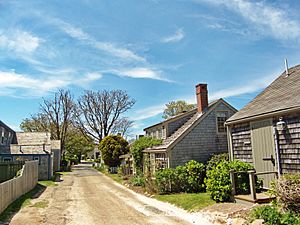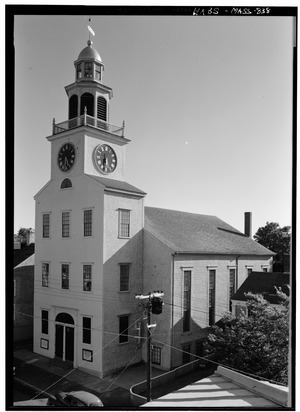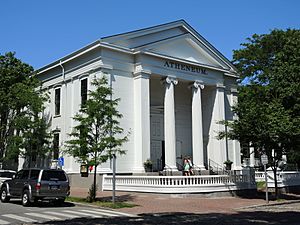Nantucket Historic District facts for kids
|
Nantucket Historic District
|
|

Main Street, Nantucket
|
|
| Lua error in Module:Location_map at line 420: attempt to index field 'wikibase' (a nil value). | |
| Location | all of Nantucket Island, Nantucket, Massachusetts |
|---|---|
| Area | 30,000 acres (12,000 ha) |
| Built | 1686 to 1849 |
| NRHP reference No. | 66000772 |
Quick facts for kids Significant dates |
|
| Added to NRHP | December 13, 1966 |
| Designated NHLD | November 13, 1966 |
The Nantucket Historic District is a very special area that protects the entire island of Nantucket, Massachusetts. It's called a National Historic Landmark District because it's important to the history of the whole country.
When it was first listed on December 13, 1966, it only included the old downtown area and the village of Siasconset. But in 1975, the protected area grew to include the whole island, plus the smaller islands of Tuckernuck and Muskeget. At over 30,000 acres, it's the biggest historic district of its kind in the main part of the United States.
Nantucket was one of the first places in the country to create a "local historic district" in 1955. This means that local rules were put in place to protect its old buildings. Since 1955, the Nantucket Historic District Commission has been in charge of making sure the island's historic buildings are kept safe and sound.
Contents
A Look Back: Nantucket's Story
Nantucket is a unique old seaport in New England. Most of its buildings were built in the late 1700s and early 1800s. This was when the whaling industry was super important to the town's economy. Whaling meant hunting whales for their oil, which was used for lamps and other things.
Whaling Days and Changes
By 1774, Nantucket had about 60% of all the whaling ships in New England! In 1840, the town was at its busiest, with about 9,000 people living there.
However, things started to change for Nantucket. Another nearby port, New Bedford, Massachusetts, became the main whaling center. Also, sandbars started forming in Nantucket Harbor. This made it hard for the bigger whaling ships to get in. So, the whaling business moved to places like Edgartown on Martha's Vineyard.
Then, in 1846, a huge fire destroyed many of the town's shops and docks. By the end of the 1800s, Nantucket's population had dropped to only 3,000 people. While other parts of the country were growing fast, Nantucket seemed to be forgotten. This "forgetting" actually helped save its historic buildings, as they weren't torn down to make way for new ones.
Saving History: Early Preservation Efforts
The first efforts to save Nantucket's history began in 1894. People worked to save the "Old Mill," a windmill built in 1746. In 1897, the mill was bought and given to the Nantucket Historical Association. Around this time, new buildings started to be built in a way that matched the island's historic style.
Architectural Styles Through Time
The oldest buildings in the historic district are from the late 1600s. They were mostly made of wood and were simple, without much decoration.
After the American Revolution, as whaling brought more money, sea captains and merchants built fancier homes. These were often in the Federal style, which was popular at the time. The Second Congressional Meetinghouse, built in 1809, is a good example. The most impressive buildings are on Main and Orange Streets.
After the big fire in 1846, the entire business area was rebuilt. New buildings were made of brick, often two or three stories tall. They mostly followed the Greek Revival style, which was popular in the 1840s.
Modern Challenges and Preservation
It wasn't until the 1990s that Nantucket's population grew past its 1840 peak of 9,000. Today, the island's economy mostly relies on tourism, especially in the summer. This has created new pressures on its historic homes.
In 2000, the National Trust for Historic Preservation listed Nantucket as one of "America's 11 Most Endangered Historic Places." This was because some people were tearing down old homes or changing them too much. They were also building new homes that were too big or didn't fit the island's historic look. This showed that even with a long history of protecting its past, Nantucket still needs people to care for its unique heritage.
Important Historic Buildings
Here are some of the important buildings you can find in the Nantucket Historic District:
- The Old Mill (built in 1746)
- Old Gaol (a jail built in 1806)
- Quaker (Friends) Meeting House (built in 1838)
- Nantucket Atheneum (a library and cultural center built in 1847)
- St. Paul's Church (built in 1901)





